吴裕雄--天生自然 R语言开发学习:中级绘图
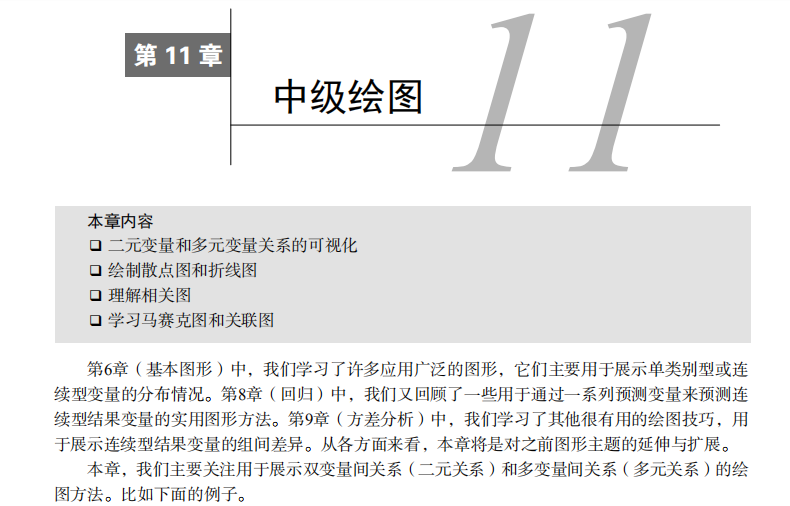
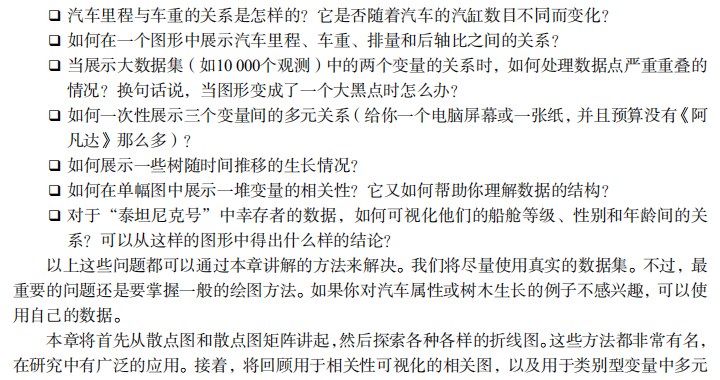
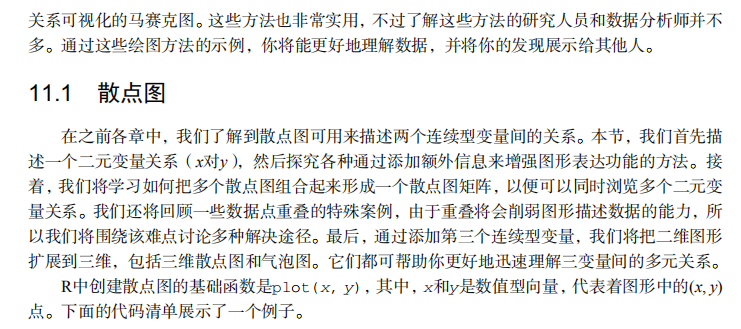

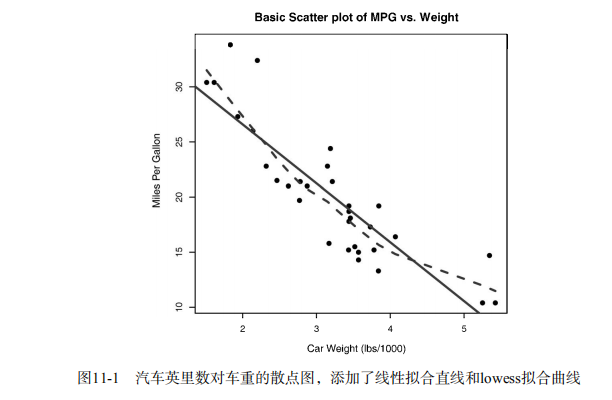

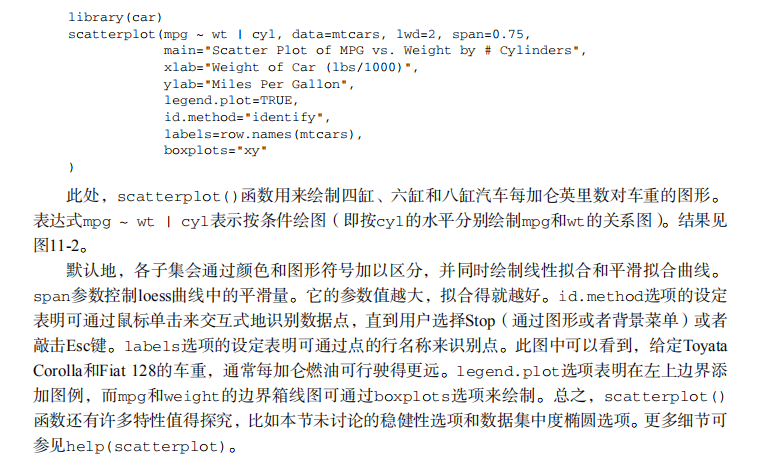


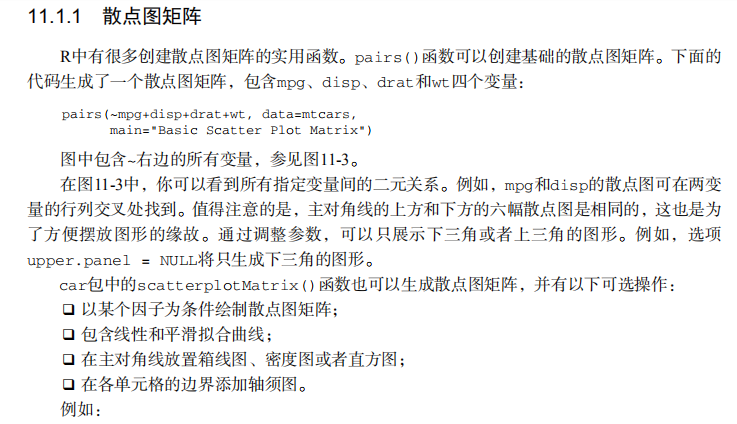

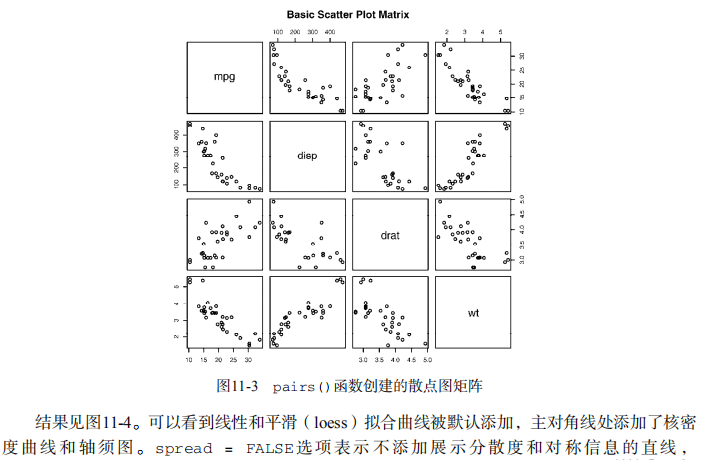

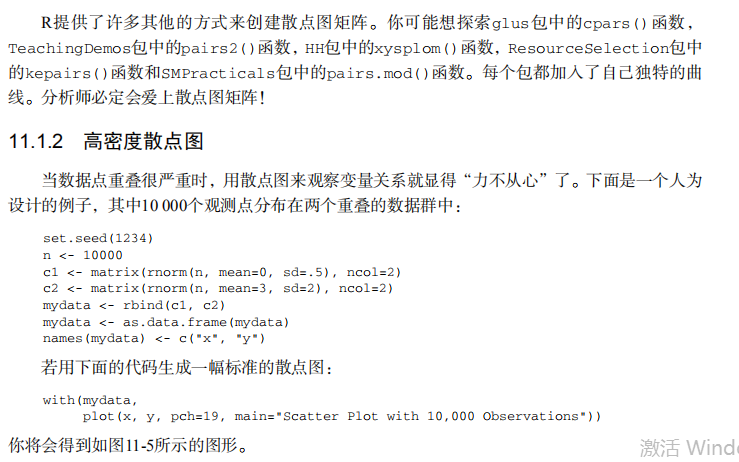
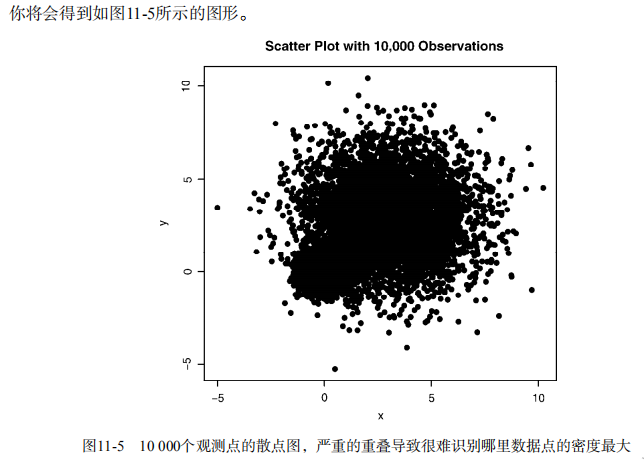

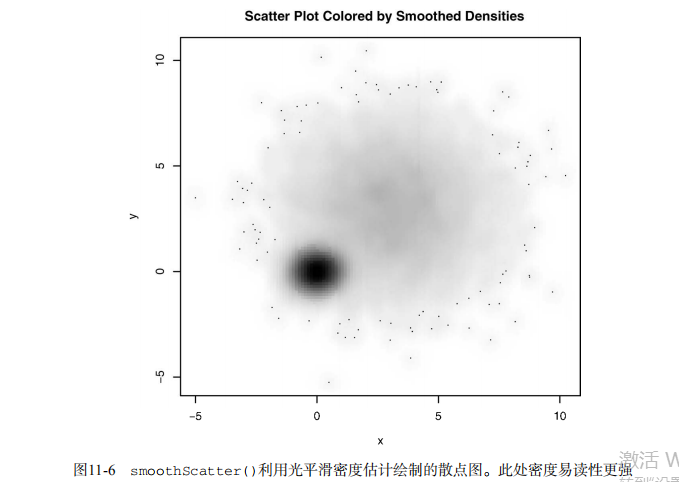

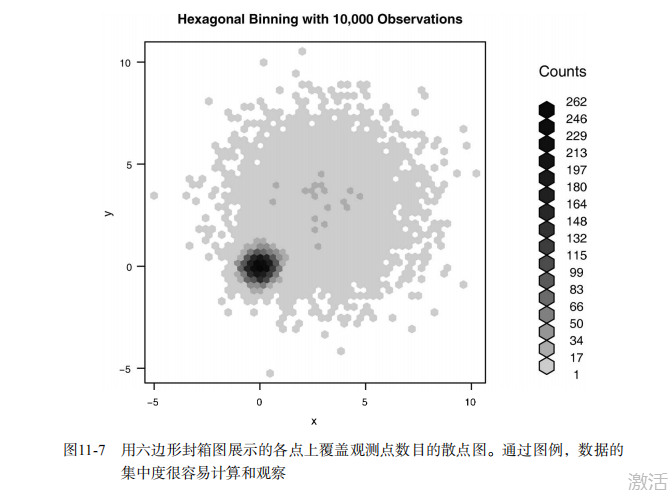

#------------------------------------------------------------------------------------#
# R in Action (2nd ed): Chapter 11 #
# Intermediate graphs #
# requires packages car, scatterplot3d, gclus, hexbin, IDPmisc, Hmisc, #
# corrgram, vcd, rlg to be installed #
# install.packages(c("car", "scatterplot3d", "gclus", "hexbin", "IDPmisc", "Hmisc", #
# "corrgram", "vcd", "rld")) #
#------------------------------------------------------------------------------------# par(ask=TRUE)
opar <- par(no.readonly=TRUE) # record current settings # Listing 11.1 - A scatter plot with best fit lines
attach(mtcars)
plot(wt, mpg,
main="Basic Scatterplot of MPG vs. Weight",
xlab="Car Weight (lbs/1000)",
ylab="Miles Per Gallon ", pch=19)
abline(lm(mpg ~ wt), col="red", lwd=2, lty=1)
lines(lowess(wt, mpg), col="blue", lwd=2, lty=2)
detach(mtcars) # Scatter plot with fit lines by group
library(car)
scatterplot(mpg ~ wt | cyl, data=mtcars, lwd=2,
main="Scatter Plot of MPG vs. Weight by # Cylinders",
xlab="Weight of Car (lbs/1000)",
ylab="Miles Per Gallon", id.method="identify",
legend.plot=TRUE, labels=row.names(mtcars),
boxplots="xy") # Scatter-plot matrices
pairs(~ mpg + disp + drat + wt, data=mtcars,
main="Basic Scatterplot Matrix") library(car)
library(car)
scatterplotMatrix(~ mpg + disp + drat + wt, data=mtcars,
spread=FALSE, smoother.args=list(lty=2),
main="Scatter Plot Matrix via car Package") # high density scatterplots
set.seed(1234)
n <- 10000
c1 <- matrix(rnorm(n, mean=0, sd=.5), ncol=2)
c2 <- matrix(rnorm(n, mean=3, sd=2), ncol=2)
mydata <- rbind(c1, c2)
mydata <- as.data.frame(mydata)
names(mydata) <- c("x", "y") with(mydata,
plot(x, y, pch=19, main="Scatter Plot with 10000 Observations")) with(mydata,
smoothScatter(x, y, main="Scatter Plot colored by Smoothed Densities")) library(hexbin)
with(mydata, {
bin <- hexbin(x, y, xbins=50)
plot(bin, main="Hexagonal Binning with 10,000 Observations")
}) # 3-D Scatterplots
library(scatterplot3d)
attach(mtcars)
scatterplot3d(wt, disp, mpg,
main="Basic 3D Scatter Plot") scatterplot3d(wt, disp, mpg,
pch=16,
highlight.3d=TRUE,
type="h",
main="3D Scatter Plot with Vertical Lines") s3d <-scatterplot3d(wt, disp, mpg,
pch=16,
highlight.3d=TRUE,
type="h",
main="3D Scatter Plot with Vertical Lines and Regression Plane")
fit <- lm(mpg ~ wt+disp)
s3d$plane3d(fit)
detach(mtcars) # spinning 3D plot
library(rgl)
attach(mtcars)
plot3d(wt, disp, mpg, col="red", size=5) # alternative
library(car)
with(mtcars,
scatter3d(wt, disp, mpg)) # bubble plots
attach(mtcars)
r <- sqrt(disp/pi)
symbols(wt, mpg, circle=r, inches=0.30,
fg="white", bg="lightblue",
main="Bubble Plot with point size proportional to displacement",
ylab="Miles Per Gallon",
xlab="Weight of Car (lbs/1000)")
text(wt, mpg, rownames(mtcars), cex=0.6)
detach(mtcars) # Listing 11.2 - Creating side by side scatter and line plots
opar <- par(no.readonly=TRUE)
par(mfrow=c(1,2))
t1 <- subset(Orange, Tree==1)
plot(t1$age, t1$circumference,
xlab="Age (days)",
ylab="Circumference (mm)",
main="Orange Tree 1 Growth")
plot(t1$age, t1$circumference,
xlab="Age (days)",
ylab="Circumference (mm)",
main="Orange Tree 1 Growth",
type="b")
par(opar) # Listing 11.3 - Line chart displaying the growth of 5 Orange trees over time
Orange$Tree <- as.numeric(Orange$Tree)
ntrees <- max(Orange$Tree)
xrange <- range(Orange$age)
yrange <- range(Orange$circumference)
plot(xrange, yrange,
type="n",
xlab="Age (days)",
ylab="Circumference (mm)"
)
colors <- rainbow(ntrees)
linetype <- c(1:ntrees)
plotchar <- seq(18, 18+ntrees, 1)
for (i in 1:ntrees) {
tree <- subset(Orange, Tree==i)
lines(tree$age, tree$circumference,
type="b",
lwd=2,
lty=linetype[i],
col=colors[i],
pch=plotchar[i]
)
}
title("Tree Growth", "example of line plot")
legend(xrange[1], yrange[2],
1:ntrees,
cex=0.8,
col=colors,
pch=plotchar,
lty=linetype,
title="Tree"
) # Correlograms
options(digits=2)
cor(mtcars) library(corrgram)
corrgram(mtcars, order=TRUE, lower.panel=panel.shade,
upper.panel=panel.pie, text.panel=panel.txt,
main="Corrgram of mtcars intercorrelations") corrgram(mtcars, order=TRUE, lower.panel=panel.ellipse,
upper.panel=panel.pts, text.panel=panel.txt,
diag.panel=panel.minmax,
main="Corrgram of mtcars data using scatter plots
and ellipses") cols <- colorRampPalette(c("darkgoldenrod4", "burlywood1",
"darkkhaki", "darkgreen"))
corrgram(mtcars, order=TRUE, col.regions=cols,
lower.panel=panel.shade,
upper.panel=panel.conf, text.panel=panel.txt,
main="A Corrgram (or Horse) of a Different Color") # Mosaic Plots
ftable(Titanic)
library(vcd)
mosaic(Titanic, shade=TRUE, legend=TRUE) library(vcd)
mosaic(~Class+Sex+Age+Survived, data=Titanic, shade=TRUE, legend=TRUE) # type= options in the plot() and lines() functions
x <- c(1:5)
y <- c(1:5)
par(mfrow=c(2,4))
types <- c("p", "l", "o", "b", "c", "s", "S", "h")
for (i in types){
plottitle <- paste("type=", i)
plot(x,y,type=i, col="red", lwd=2, cex=1, main=plottitle)
}
吴裕雄--天生自然 R语言开发学习:中级绘图的更多相关文章
- 吴裕雄--天生自然 R语言开发学习:R语言的安装与配置
下载R语言和开发工具RStudio安装包 先安装R
- 吴裕雄--天生自然 R语言开发学习:数据集和数据结构
数据集的概念 数据集通常是由数据构成的一个矩形数组,行表示观测,列表示变量.表2-1提供了一个假想的病例数据集. 不同的行业对于数据集的行和列叫法不同.统计学家称它们为观测(observation)和 ...
- 吴裕雄--天生自然 R语言开发学习:导入数据
2.3.6 导入 SPSS 数据 IBM SPSS数据集可以通过foreign包中的函数read.spss()导入到R中,也可以使用Hmisc 包中的spss.get()函数.函数spss.get() ...
- 吴裕雄--天生自然 R语言开发学习:使用键盘、带分隔符的文本文件输入数据
R可从键盘.文本文件.Microsoft Excel和Access.流行的统计软件.特殊格 式的文件.多种关系型数据库管理系统.专业数据库.网站和在线服务中导入数据. 使用键盘了.有两种常见的方式:用 ...
- 吴裕雄--天生自然 R语言开发学习:R语言的简单介绍和使用
假设我们正在研究生理发育问 题,并收集了10名婴儿在出生后一年内的月龄和体重数据(见表1-).我们感兴趣的是体重的分 布及体重和月龄的关系. 可以使用函数c()以向量的形式输入月龄和体重数据,此函 数 ...
- 吴裕雄--天生自然 R语言开发学习:基础知识
1.基础数据结构 1.1 向量 # 创建向量a a <- c(1,2,3) print(a) 1.2 矩阵 #创建矩阵 mymat <- matrix(c(1:10), nrow=2, n ...
- 吴裕雄--天生自然 R语言开发学习:图形初阶(续二)
# ----------------------------------------------------# # R in Action (2nd ed): Chapter 3 # # Gettin ...
- 吴裕雄--天生自然 R语言开发学习:图形初阶(续一)
# ----------------------------------------------------# # R in Action (2nd ed): Chapter 3 # # Gettin ...
- 吴裕雄--天生自然 R语言开发学习:图形初阶
# ----------------------------------------------------# # R in Action (2nd ed): Chapter 3 # # Gettin ...
- 吴裕雄--天生自然 R语言开发学习:基本图形(续二)
#---------------------------------------------------------------# # R in Action (2nd ed): Chapter 6 ...
随机推荐
- 吴裕雄--天生自然ShellX学习笔记:Shell 文件包含
和其他语言一样,Shell 也可以包含外部脚本.这样可以很方便的封装一些公用的代码作为一个独立的文件. Shell 文件包含的语法格式如下: . filename # 注意点号(.)和文件名中间有一空 ...
- PAT Advanced 1037 Magic Coupon (25) [贪⼼算法]
题目 The magic shop in Mars is ofering some magic coupons. Each coupon has an integer N printed on it, ...
- python格式化输出的三种形式
法一: list_a = [1, 2, 3] str_b = 'aaa' string = "There are two contents:%s, %s" % (list_a, s ...
- Django专题之ORM操作2
Django ORM操作 目录 一般操作 看专业的官网文档,做专业的程序员! 回到顶部 必知必会13条 <1> all(): 查询所有结果 <2> get(**kwargs ...
- win10下安装cygwin全过程
简单讲:cygwin就是在windows系统上跑linux和unix的环境,跨平台移植的应用程序移植. 安装步骤: 下载cygwin: 打开官网https://cygwin.com/install.h ...
- linux安装nginx步骤
转载自:https://blog.csdn.net/t8116189520/article/details/81909574,修改部分内容 本文已收录至博客专栏linux安装各种软件及配置环境教程中 ...
- 利用GetCharWidth32获取字符串宽度2
/////////////////////////////////////////////////////////////// // 04FirstWindow.cpp文件 #include < ...
- 填平新版本Xcode安装插件不成功的坑
一般情况下,安装xcode不成功现象基本上都出现在更新xcode或者重装之后出现的情况,下面原理性德东西,我就不赘述了,度娘上很容易看到,通过这段只是希望大家花费尽量少得时间将xcode插件安装成功. ...
- 基于Linux下的C语言项目实战--本地账号管理系统
C语言开发项目实战: C语言是一门通用计算机编程语言,广泛应用于底层开发.C语言的设计目标是提供一种能以简易的方式编译.处理低级存储器.产生少量的机器码以及不需要任何运行环境支持便能运行的编程语言.尽 ...
- 10)global预定义变量
代码展示: <!DOCTYPE html PUBLIC "-//W3C//DTD XHTML 1.0 Transitional//EN" "http://www.w ...
